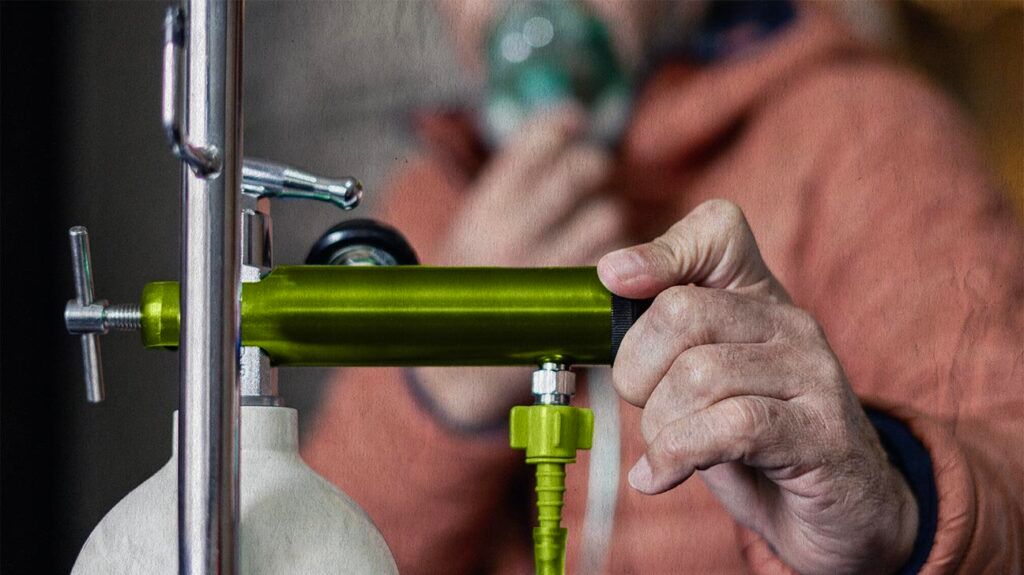Oxygen therapy can help treat cluster headaches. However, current research does not support its use for migraine and other headache types.
Oxygen therapy involves breathing in air that contains 100% oxygen through a specialized device. The air around us contains about 20% oxygen.
This form of therapy can help relieve low blood oxygen, and doctors commonly use it to help people with lung damage absorb more oxygen in their lungs.
Some research also supports its use as a treatment for cluster headaches. Read on to learn more.

Oxygen therapy provides a person with supplemental oxygen. It is often available for those living with lung conditions.
Cluster headaches
Some evidence suggests oxygen therapy can also help relieve cluster headaches. The American Migraine Foundation supports the use of oxygen therapy for this purpose.
Short bursts of oxygen may help relieve symptoms of an acute cluster headache quickly and safely in some people. Some evidence suggests
A
However, experts are still unsure how exactly oxygen therapy provides relief for cluster headaches. Some
Other headache types
While some research suggests oxygen therapy may help treat other types of headaches, there are limits to the studies supporting this.
The 2022 review article found it minimally beneficial for other headache types.
A 2018 feasibility study found that oxygen therapy helped with medication-overuse headaches during withdrawal. However, this study was small, with only 20 participants. The researchers also permitted participants to use other medications throughout the study, which likely affected the outcomes.
As such, more research on this topic is necessary.
There is currently not much research on the use of oxygen therapy for migraine.
A
However, a
Scientists need to perform more research to help them understand whether oxygen therapy can be an effective treatment option for migraine.
A doctor will need to prescribe oxygen for use at home for cluster headaches.
In doing so, they will need to define:
- The flow rate: This describes how fast oxygen moves from the machine to the body.
- The concentration of oxygen: This defines the percentage of the stored air that is oxygen.
- Delivery method: This might include a face mask or nasal prongs, also known as a cannula.
Accessibility
Problems with accessibility can be a significant drawback of using oxygen therapy for cluster headaches.
Oxygen therapy is expensive. A
Several barriers currently prevent the widespread use of oxygen therapy for cluster headaches,
- low awareness among healthcare professionals of oxygen therapy as a treatment option for this condition
- problems accessing home oxygen systems
- coverage issues with health insurers
However, Medicare updated coverage in 2022 to include coverage for home oxygen therapy as a treatment for acute or chronic cluster headaches.
Although oxygen therapy cannot treat most headaches, other treatments can help relieve severe or continuous headache pain.
There are several types of headaches, each with
Cluster headaches
Aside from oxygen therapy, treatment options for cluster headaches may involve:
- triptan drugs, either as an injection or nasal spray
- dihydroergotamine injections
- calcitonin gene-related peptide monoclonal antibodies
- topiramate
- verapamil
- lidocaine
- lithium carbonate
Some of these options may be suitable during a cluster headache episode, while others are for prevention.
Migraine
Migraine treatment will depend on the symptoms, frequency, duration, and how well the person responds to certain medications.
Acute treatments
- triptans
- ergot derivatives
- over-the-counter pain relief
- nausea relief drugs
- prescription narcotics for brief periods
Preventive medications may include:
- anti-seizure medications
- beta-blockers
- calcium channel blockers
- antidepressant medications
Secondary headaches
A range of health conditions can cause headaches as a symptom, such as
- infections of the head and neck
- head trauma
- any issues directly affecting the brain
These are known as secondary headaches. Treating the underlying condition often relieves the headache.
However, doctors may recommend or prescribe nonsteroidal anti-inflammatory drugs (NSAIDs), pain relief medications, or other medications that can relieve headache symptoms while managing an underlying condition.
The most effective home remedies may depend on the type of headache a person is experiencing and the cause.
For example, dehydration can cause migraine episodes and headaches. Maintaining sufficient hydration can help prevent these headaches.
Dimming the lights may also help relieve a migraine attack.
Other options may include:
- using a cold compress on the neck or head
- getting enough high quality sleep, as sleep issues
can contribute to headaches - limiting alcohol intake, as alcohol can act as a trigger in roughly
33% of people with migraine - managing stress as much as possible by practicing relaxation techniques, such as:
- mindfulness
- meditation
- scalp massage
- yoga
Headache and migraine resources
To discover more evidence-based information and resources for headaches and migraine, visit our dedicated hub.
Oxygen therapy is a treatment option for cluster headaches. However, oxygen therapy is difficult and costly to set up at home, and insurance does not always cover it as a treatment for cluster headaches.
Currently, there is not much research exploring oxygen therapy for other headache types, such as migraine. The available research does not show the same benefits for other types as for cluster headaches.
People experiencing frequent, severe, or disabling headaches should contact a doctor for a diagnosis. Many different treatments can help prevent and treat headache episodes.
